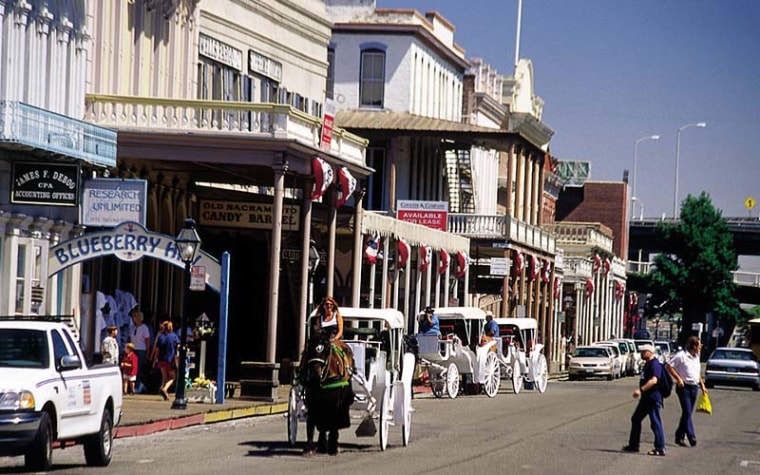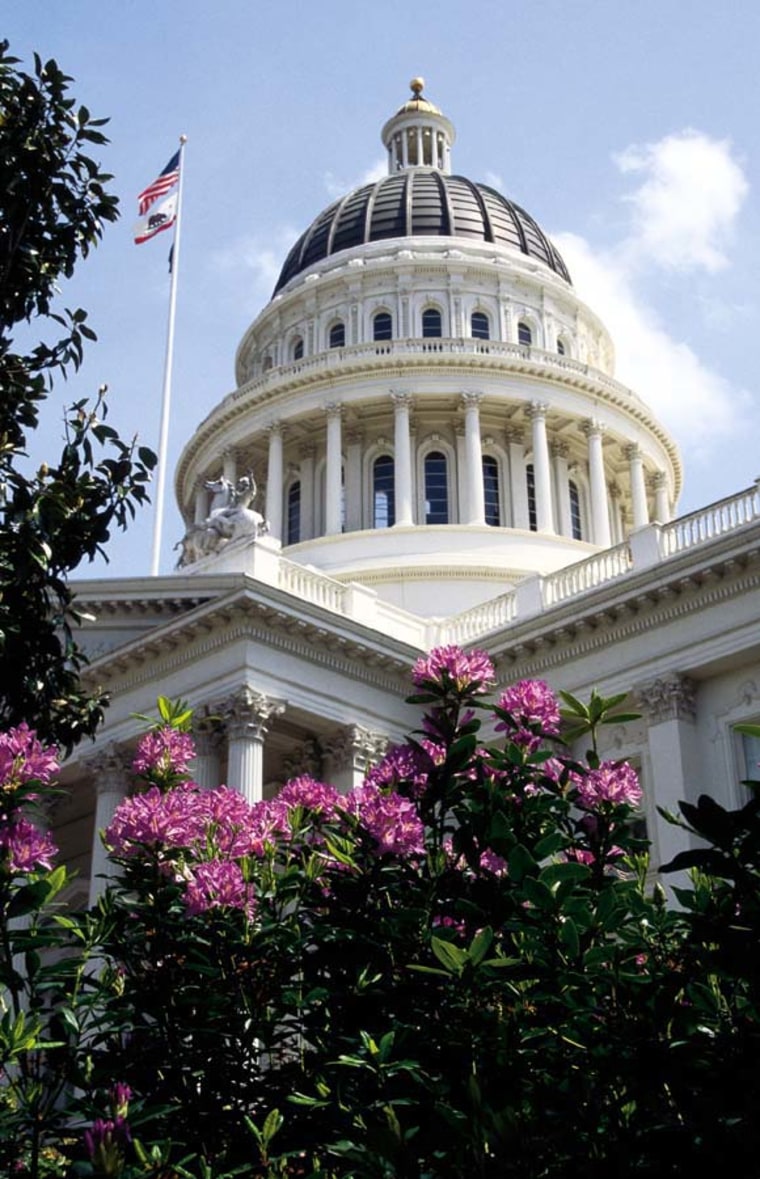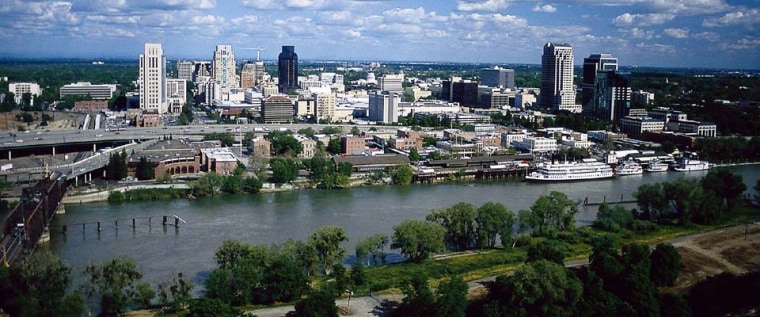If you're looking for hot nightlife and a wild bit of debauchery, Sacramento wouldn't be your kind of town.
As California's capital, it's a buttoned-down sort of place. While I didn't see any of the "girlie men" Gov. Arnold Schwarzenegger complains of, there were more regular guys in white shirts and ties than I believe exist in all other California cities combined.
But Sacramento is a graceful, pleasant, easygoing place. Sandwiched between the American and Sacramento rivers, it's a great town for history, politics, biking, walking and floating, either on a river boat, in a water taxi or in a tube.
Although it's small, the city's neighborhoods are varied. Around the Capitol building, Sacramento looks a bit like Washington, except prettier, due to the giant sequoias and palm trees that line the grassy mall.
A district filled with fine old homes is reminiscent of St. Charles Avenue in New Orleans. In central downtown, the outdoor cafes and coffee shops and bookstores lend the feel of an upscale college town.
Old Sacramento brings to mind the Gold Rush, the great transcontinental Atlantic-Pacific Railway and the Pony Express—all of which once began and ended here.
Now that JetBlue's entrance into the market has forced other carriers to slash their fares from the East, Sacramento is positioned to resume its place in history as a major gateway to the California West.
The city is just about an hour's drive to Napa Valley, about an hour and a half to Sonoma Valley wineries and the spas of Calistoga, and a hop and a jump to Gold Rush country. It's a very short, pleasant drive to snow-capped mountains, lakes and white water, and about a three-hour drive to Lassen Volcanic National Park and the Oregon border.
It would be a mistake, however, to buzz right through town on the way to something else. I gave it two days, which is just about right, unless you want to use it longer as a base to nearby attractions.

Most of my first day was spent in Old Sacramento, which boomed for a time in the 1800s, when gold was found in the nearby foothills. In fact, the Gold Rush is said to have spurred one of the largest recorded mass migrations in history. The old part of the city fell on hard times in the 1900s and became a slum. City planners carefully resurrected it in the 1960s.
It could easily have become one of those dead, re-created-village places where people in period customs run around, not fooling you for a minute. Instead, the city allowed merchants to open real restaurants and shops in some of the 53 historic buildings, making it feel not only historic but alive.
The 28-acre site with National Landmark status also holds several small museums, such as the Wells Fargo History Museum and the extensive, 100,000-square-foot Museum of Railroad History, part of the California State Railroad Museum complex.
From now on, whenever I see road crews working on the same little bit of asphalt for months at a time, I'll be thinking of the exhibits about the railroad men working with their bare hands in the wilderness, carving passages through solid rock and laying 10 miles of track a day.
The museum has on permanent exhibit 21 restored locomotives and cars from the 1860s through the 1960s, and I must say it's a bit disconcerting to see in a museum the kind of cars you remember riding.
I had planned to rent a bike to explore the extensive paths along the river and the city after hitting a couple more of Sacramento's 15 museums. But I happened to be there in July, when temperatures hit their peak, averaging 93 degrees during the day. Locals point out that it's a dry heat, which might be why I felt the need to repair to the hotel swimming pool.
By September, average temperatures fall to 87 degrees, and in October, they average a balmy 78. Really, the only time to avoid Sacramento heat is July and August: The winters are mild, with sunny days in the 50s and 60s. April averages jump to 71, and May and June remain in the low 80s, on average.

Even in the hottest two months, temperatures dip into the 60s in the evening and early morning. In fact, on my second day in Sacramento, I began by enjoying the cool of the morning at a cafe in the modern downtown. I strolled to the State Capitol, a building similar to but somewhat more luxurious than the U.S. Capitol and found no lines.
Guided tours are available, but don't you often find that guides tell you way more than you feel a need to know? I chose a self-guided tour. Once you pass through a metal detector, security officers allow you free rein to just wander around.
If you go, watch the walls for the portraits of former governors. My favorite display was of the somber portraits of Pete Wilson (1991-99) and George Deukmejian (1983-91) looking very important and official, hanging next to a somewhat wild and abstract, close-up rendering of the face of Jerry Brown (1975-83).
From the Capitol, I headed to Sutter's Fort, where the first settlers set up camp in 1839. When I reached the grounds, however, I noticed the California State Indian Museum next door and decided to stop there first.
It's a modest, somewhat dusty little place, but the exhibits are worth a look. You come away knowing that there were an estimated 150,000 Indians in the area on Jan. 24, 1848, when James Marshall stuck his hand in the American River and pulled out a shiny nugget of gold. Ten years later, only 20,000 natives survived.
It was legal to kill Native Americans in California until 1866, according to the exhibit, which also details how survivors were marched to a reservation in Mendocino.
The displays killed my appetite for seeing the fort, so I headed instead to a downtown Imax theater that shows about a half-dozen different movies each day. I chose one about the Lewis and Clark expedition and the amazing Indian woman, Sacajawea,who not only helped lead the men and translate for them, but just happened to have a baby along on the journey, as well. She was no girlie-girl.
For dinner, I hit the Esquire Grill, one of the several restaurants said to be frequented by the new governor, who lives in the Hyatt Regency when he's in town to legislate. He didn't show up, but I can say one thing for him: The man has good taste in food.
Details: Sacramento
GETTING THERE: A fierce fare war that erupted when JetBlue began flying to Sacramento nonstop from Dulles has severely depressed prices. Fares for nonstop round-trip flights on United and JetBlue have gone as low as $198 (although JetBlue offers only a red-eye return). Fare at press time was about $245.
WHERE TO STAY: The Delta King Hotel (1000 Front St., 800-825-5464, ) offers rooms in a 1927 paddlewheel boat moored on the Sacramento River in the midst of Old Sacramento. Doubles start at $109.
Gov. Schwarzenegger's choice when he's in town for legislative business is the Hyatt Regency (1209 L St., 888-591-1234 , ). Since it's a business hotel, rates are lower on weekends -- I paid $129 per night on a Friday and Saturday night. Weekdays are more typically $189 and up.
A good B&B option: the Amber House (1315 22nd St., 800-755-6526, ), where breakfast is served in your room. Rates begin at about $149.
The Radisson (500 Leisure Lane, 888-201-1718, ) is a few miles out of town, but has spacious rooms and upscale facilities at good prices. Standard rates begin at $109, although I found Internet rates for as low as $79.
WHERE TO EAT: The Esquire Grill (1213 K St.) is one of several Sacramento restaurants favored by the new governor. American-style food is served indoors or on an outdoor patio. Steaks with blue cheese butter were grilled to perfection. Entrees begin at $13.75 (steaks at $22.50).
Other restaurants frequented by Arnold include Lucca Restaurant and Bar (1615 J St.), specializing in California Mediterranean, with entrees beginning at $8.95; and Biba (2801 Capitol Ave.), a classy Italian restaurant operated by TV chef and cookbook author Biba Caggiano, with entrees beginning at $18.50.
An eclectic international mix of foods is offered at the Tower Cafe (1518 Broadway), the birthplace of Tower Records. Entrees begin at about $8.
THINGS TO DO:
• Try horseback riding at Gibson Ranch Park Equestrian Services, a 365-acre county park and ranch. Details: 916-991-7592,
• Cruise and dine in a Victorian setting on the riverboat, Spirit of Sacramento (110 L St., 800-433-0263, ).
• Hit the whitewater on rafts or kayaks with W.E.T. River Trips (888-723-8938, ) in Sacramento or several outfitters just outside of town. Check the visitors bureau's Web site (see below).
• Rent a bike for guided or self-guided tours at Bike Sacramento (1050 Front St., 916-444-0200).
INFORMATION: For details on 15 museums and other activities: Sacramento Convention and Visitors Bureau, 800-292-2334, .
